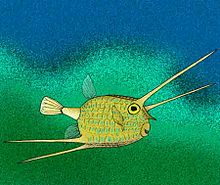Monte Bolca is a lagerstätte near Verona, Italy that was one of the first fossil sites with high quality preservation known to Europeans, and is still an important source of fossils from the Eocene.
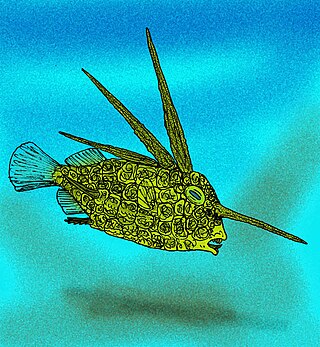
Eospinus daniltshenkoi is an extinct tetraodontid bony fish from the Eocene. Its fossils are from the Danata Formation lagerstatten of Ypresian Turkmenistan.

Ceratoichthys is an extinct genus of lookdown-like prehistoric jackfish that lived during the late Ypresian epoch, of the Early Eocene. It contains a single species, C. pinnatiformis of Monte Bolca, Italy. It and Vomeropsis are the only known members of the extinct subfamily Vomeropsinae.

Proaracana dubia is an extinct, prehistoric aracanid boxfish that lived during the Lutetian of middle Eocene Monte Bolca.

Spinacanthus cuneiformis is an extinct prehistoric tetraodontid bony fish that lived from the Lutetian epoch of Eocene Monte Bolca.
Calamostoma is an extinct relative of the ghost pipefish that lived during the early Eocene. It contains a single species, C. lesiniforme from the famous Monte Bolca site of Italy. It is one of the few known fossil ghost pipefishes. Calamostoma and the other Bolca solenostomid, Solenorhynchus, are both placed in the extinct subfamily Solenorhynchinae.
Anguilloides is an extinct genus of prehistoric marine eel that lived in the early Eocene. It contains a single species, A. branchiostegalis. Fossils are known from the famous Monte Bolca site of Italy.

Bolcyrus is an extinct genus of prehistoric marine eel that lived during the Early Eocene. It was a member of the family Congridae, which also contains modern conger eels.
Bolcanguilla is an extinct genus of prehistoric marine eel that lived during the early division of the Eocene epoch. It contains a single species, B. brachycephala from the Monte Bolca site of Italy. Its exact taxonomic affinities within the Anguilliformes remain uncertain.

Acanthonemus is an extinct genus of prehistoric marine ray-finned fish that lived from the early Eocene. It contains a single species, A. subaureus, known from the famous Monte Bolca site in Italy. It is the only genus in the extinct family Acanthonemidae.
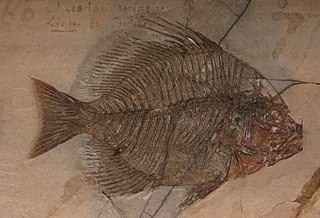
Archaephippus is an extinct genus of prehistoric spadefish that lived from the early Eocene. It contains a single species, A. asper, known from Italy. Several exquisitely preserved fossils have been found from the Monte Bolca lagerstatten. Some juvenile specimens preserve the vertical striped coloration that they would have likely had in life.
Callipteryx is an extinct genus of prehistoric marine trachiniform fish that lived during the early Eocene. It is the only known member of the extinct family Callipterygidae. It is thought to have been a relative of weeverfishes.
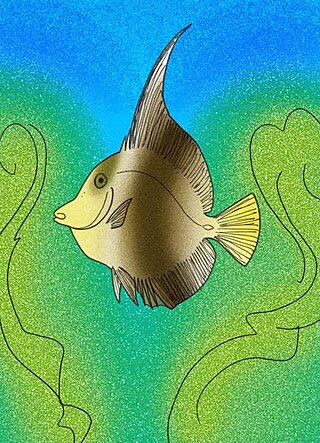
Eozanclus brevirostris is an extinct relative of the Moorish idol that lived during the late Ypresian epoch of the Eocene in what is now Monte Bolca, northern Italy. It differs from its living relative by having a much shorter snout.

Psettopsis subarcuatus is an extinct prehistoric species of moonyfish that lived during the Lutetian epoch of Monte Bolca, Italy.
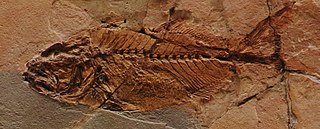
Carangopsis is an extinct relative of the bluefish that lived during the early Eocene. It contains two species, both from the famous Monte Bolca site of Italy.

Carangodes is an extinct genus of prehistoric ray-finned fish that lived during the early Eocene. It contains a single species, C. bicornis, from the famous Monte Bolca site in Italy. It is the only known member of the extinct perciform family Carangodidae.

Eoplatax is an extinct genus of prehistoric spadefish that lived during the Lutetian of Monte Bolca. They are closely allied to the extant genus, Platax, more commonly known as "batfish."
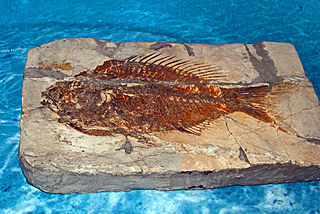
Sparnodus is an extinct genus of prehistoric perciform fish in the family Sparidae. Species of this genus were nektonic carnivores. These fishes lived in the Cenozoic Era, in the Oligocene and Paleocene.

Protobalistum imperiale is an extinct prehistoric tetraodontid bony fish that lived from the Lutetian epoch of Eocene Monte Bolca.

Spinacanthidae is an extinct prehistoric family of tetraodontid bony fish that lived from the Lutetian epoch of Eocene Monte Bolca.
